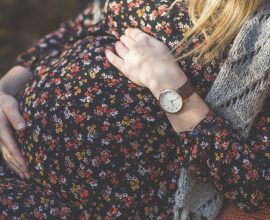Stages of Fetal Development
All of us spent the first nine months of our existence surrounded by the water of the womb.
| Explore the first stages of human development below. |
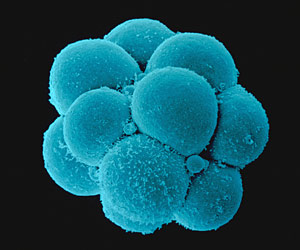
Month 1: Human development starts when a sperm fuses with an egg to create a zygote. A zygote is a new single-cell human life that contains two copies of chromosomes – one copy from each parent. In the week following fertilization, the zygote undergoes rapid cell division and becomes a mass of cells known as a blastocyst. Just 12 days after fertilization, the cells destined to become the baby turn into something else first: the embryo. By the month’s end, this embryo is about the size of a grain of rice, but already, his/her surface features and major organs – the heart, lungs, liver and kidneys – are starting to take shape.
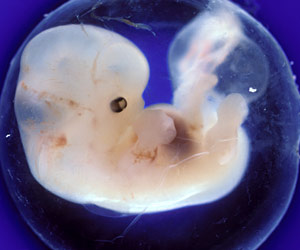
Month 2: This month, the tiny embryo’s development shifts into high gear. His/her tongue, teeth and eyelids start to form. His/her limbs grow longer and stronger, and the palate is nearly complete. Also in this time period, the embryo’s gastrointestinal tract separates from the urogenital organs and the heart begins beating – twice as fast as yours, in fact. The essential organs all are under construction and major body parts are in place (legs, arms, head, and torso). As the eighth week of pregnancy draws to a close, one more major development unfolds. The embryonic baby gets a final name change, and he/she is now called a fetus until birth.
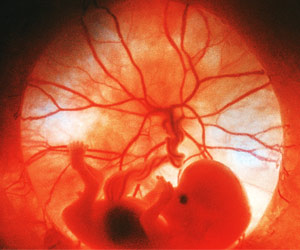
Month 3: This is the month of the heartbeat. Using a special tool called a Doppler monitor, doctors can detect the tiny thump-thumps of a 10-week-old fetus. This is also a time of rapid growth inside the womb. By month’s end, the unborn baby will weight roughly 1 ounce, and will double in length, uncurling from a tight C-position until he/she is about 3 inches long. The tail will disappear and eyelids, earlobes, limbs, and digits will continue to form. Other developmental milestones for this period include thumb-sucking, head-nodding and balling tiny fingers into fists. And though the unborn baby’s reproductive organs now are under construction, it’s still a bit early for the doctor’s gender declaration. That news (should you want it) usually arrives early in pregnancy’s second trimester.
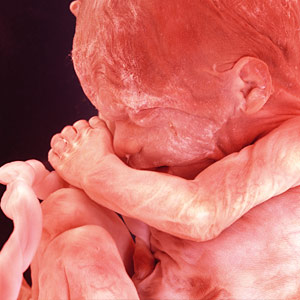
Month 4: Get out the headphones and tune the radio dial to Mozart — this month, the fetus can hear his/her mother’s heartbeat, her voice and other outside noises. The unborn baby is also developing at warp speed; by now, all major organs are complete. In addition, his/her bones are growing stronger and its muscles longer. Reflexes also are sharpening up — the baby can now swallow, kick and execute an occasional somersault with relative ease. And by month’s end, the unborn baby will weigh around 6 ounces and stretch some 7 inches long. Sweat glands will dot his/her palms and soles, and the baby’s wrinkly skin will shine transparent pink. At this stage, the unborn baby may look like a complete package, but it still has a few more months of growing to do. By the end of month four, most doctors can perform an ultrasound test and identify the baby’s gender.
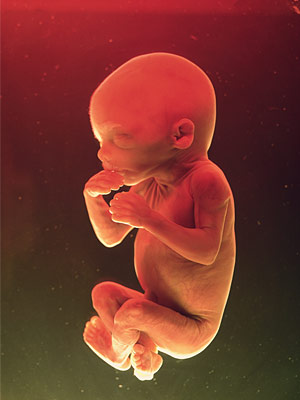
Month 5: Finally, the baby really starts kicking! “Quickening” is when a mother senses her potential punter in action for the first time, and this milestone moment usually happens during pregnancy’s fifth month. Also new in this month: hair. The fetus now has tiny white eyelashes and two arching eyebrows. Fine woolly hairs, called lanugo, blanket the body and the baby’s bare head also sports a few sprouts. In addition to lanugo, a white, waxy substance called vernix caseosa covers and protects the fetus’s body. And by month’s end, the unborn baby measures 8 to 10 inches long and tips the scales at 1 pound.
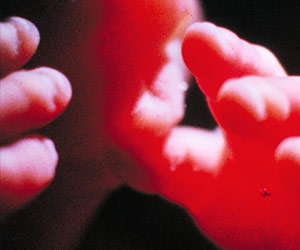
Month 6: Month 6 marks the end of the second trimester. At this point, the baby’s essential organs — its kidneys, heart and lungs — are fully formed. The facial features are becoming more recognizable. he/she also can hiccup and react to loud “outside” noises by blinking, shifting or kicking. By month’s end, the fetus will measure about 12 or 13 inches long and weigh roughly 2 pounds.
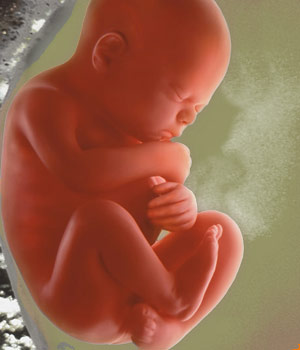
Month 7: The 7-month-old fetus can blink, and his/her eyes may even remain open for short period of time. Hands and feet are becoming even more active. Also in this phase: Taste buds form and protective fat tissue makes its debut. The unborn baby’s hearing is fully developed and, in boys, the testicles have moved to the groin. By month’s end, the unborn baby will measure 14 to 16 inches long and weigh anywhere from 2 ½ to 3 ½ pounds.
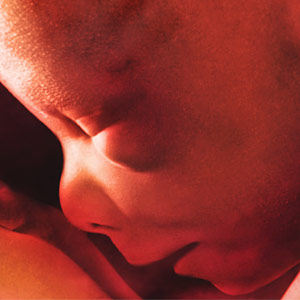
Month 8: This month, the unborn baby’s brain develops rapidly, and all of his/her organs except the lungs are mature. An 8-month-old fetus stretches 16 to 18 inches long and weighs between 4 and 6 pounds. And as the baby-to-be grows larger, space in the womb becomes scarce. Expectant mothers should still count on catching a few elbows every day, but the elaborate somersault sequences should stop until delivery day. Other exciting changes during this period? The baby’s fingernails now reach beyond his/her fingertips and the skin is starting to smooth.
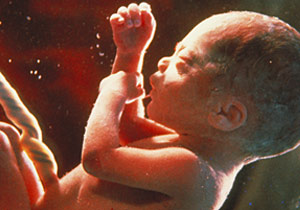
Month 9: The finish line is in sight! In this final month of development, the baby’s fat layers thicken to help keep him/her warm outside the womb, and the protective layers of vernix caseosa and lanugo largely disappear. By now, the unborn baby’s lungs are mature, the is skin pink and smooth, and the baby’s are toenails fully grown. The baby-to-be can also execute an array of reflexes, such as head turning, blinking and grasping. At this late stage, it stretches between 20 to 22 inches long, and weighs about 7½ pounds. To prepare itself for delivery, the baby changes position and drops down in his/her mother’s pelvis, usually with the head pointed toward her birth canal.
Sources: The National Women’s Health Information Center via the U.S. Department of Health and Human Service (www.4women.gov) and The Office of Public Health’s website, 4parents.gov.




